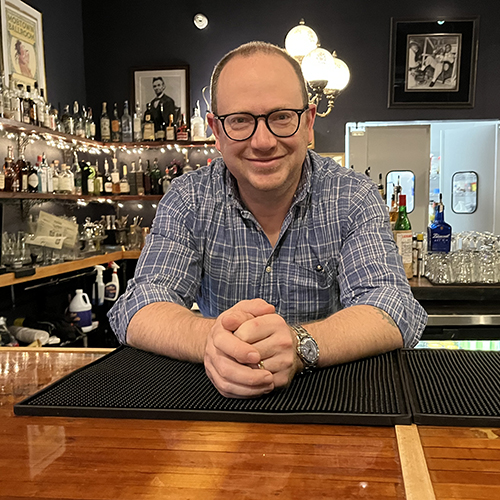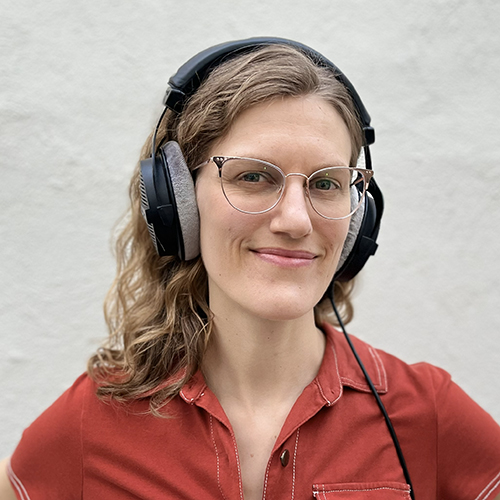Blizzard is distracted. He’s gnawing a hefty bone set in a block of ice.
“He won’t look up for a while,” says Cindy Roberts (BA, Psychology, 2001), observing through a glass panel in the polar bear exhibit at Tacoma’s Point Defiance Zoo & Aquarium. “That’s one of his favorite treats.”
As one of the zoo staff biologists who cares for polar bears, Roberts helps monitor and maintain the diet and overall health of 22-year-old Blizzard and 32-year-old Boris. She also cares for puffins, penguins, sea otters, and walruses in the zoo’s Rocky Shores/Arctic Tundra area. Roberts previously cared for animals in the aquarium, and helped with the zoo’s farm animals.

A visit to a zoo in Denver first piqued Roberts’ interest in zookeeping. She was 20 at the time, trying to figure out next steps in her life. Watching a keeper working with an elephant led to an epiphany. “In that moment, I knew I wanted to work at a zoo,” she recalls. “I go with my gut, and I just knew that was the path I wanted to take.”
There was just one problem: zoos require their keepers to have a college degree, and Roberts hadn’t gone to college. So while working full-time at Alaska Airlines, she began taking night classes at Highline College and volunteering at Point Defiance Zoo. “Saturday was the day I volunteered,” she recalls, “and Sunday was my study-like-crazy day.”
Zookeepers are ambassadors for the animals we care for. We passionately love them and want to help their wild counterparts as well.
Roberts later transferred to the UW, where she studied psychology through the Evening Degree Program (since phased out). Around the same time, she was offered a temporary paid zoo position. Point Defiance Zoo was caring for sea otters on loan from a zoo undergoing renovations, and Roberts was hired to help. After completing her BA, she moved into a permanent, full-time position.
Roberts spent the next eight years as a keeper immersing herself — literally — in the zoo’s aquarium. Much of her time was spent underwater in scuba gear, tending to marine animals. She was lead keeper for jellyfish and the giant Pacific octopus, responsible for their feeding and general health, but she also spent time with other aquarium animals. An unglamorous but important part of the job was cleaning tanks, including the 225,000-gallon shark exhibit.

“Being in the shark tank was the most relaxing place,” says Roberts. “Basically you have one person cleaning the windows and the other person keeping an eye on the sharks. We didn’t interact with them too much, other than to make sure we were staying out of their way. It may not sound that exciting, but getting in that shark tank was a blast.”
In 2009 Roberts transferred to the Rocky Shores/Arctic Tundra area, where she was assigned to the tufted puffins but also found opportunities to help with other species, including the polar bears. The bears have been her main focus for the past seven years.
The zoo’s two polar bears have very different histories. Boris, the elder statesmen, was rescued from a traveling circus in Mexico. Blizzard came to the zoo as a cub. He’d become separated from his mother on the Arctic tundra, and had no chance of survival in the wild.
“Boris is the mellower one, even more so with age,” says Roberts. “Blizzard is pretty intense. He looks at you as if he’s waiting for his prey. He’s a polar bear, so we respect that. We provide enrichment to bring out that polar bear behavior.”

To stimulate the bears mentally and physically, keepers introduce activities that involve problem-solving and physical activity, always with a barrier between the human and bear. They also train the bears in natural behaviors, to show zoo visitors what polar bears might do in the wild. But perhaps the most important training is designed to improve the bears’ medical care. While eating treats, the bears are trained to place their paw in a box, from which the zoo’s veterinary staff can take blood samples.
“Getting blood samples is super helpful because the bears hide it when they’re sick, and older bears have trouble with kidney issues,” says Roberts. (Boris is well past the 21-year median life expectancy for a male polar bear.) “The blood tests allow us keep track of their kidneys and ensure that Boris’s medications are not affecting his kidneys or liver.”
Such measures are not possible for polar bears in the wild, like those Roberts observed through a Polar Bears International program in 2015. The week-long program brought 12 zookeepers and 3 facilitators to the northern Canadian town of Churchill, Manitoba — “The Polar Bear Capitol of the World” — to learn about habitat preservation for the bears. Roberts will visit Churchill again in 2019 as a field ambassador for Polar Bears International, educating tourists about polar bears and how to protect them.
Closer to home, Roberts already shares her knowledge in presentations for zoo visitors and talks in local schools. Her message is clear: climate change is threatening the bears’ natural habitat, and we can combat climate change by releasing less carbon dioxide into the atmosphere. A simple first step, she says, is to avoid idling our cars. She shares her “idle less for wildlife” message in all her talks.
“Zookeepers are ambassadors for the animals we care for,” Roberts says. “We passionately love them and want to help their wild counterparts as well. An important part of the job is to educate visitors and do work in the field to help protect animals. We want them to thrive. We want them to be around for future generations.”
More Stories

A Love of Classics and Ballroom
Michael Seguin studied Classics at the UW and now owns Baltimore's Mobtown Ballroom. The two interests, he says, are more connected than they might seem.

Bringing Music to Life Through Audio Engineering
UW School of Music alum Andrea Roberts, an audio engineer, has worked with recording artists in a wide range of genres — including Beyoncé.

A Sports Obsession Inspires a Career
Thuc Nhi Nguyen got her start the UW Daily. Now she's a sports reporter for Los Angeles Times, writing about the Lakers and the Olympics.